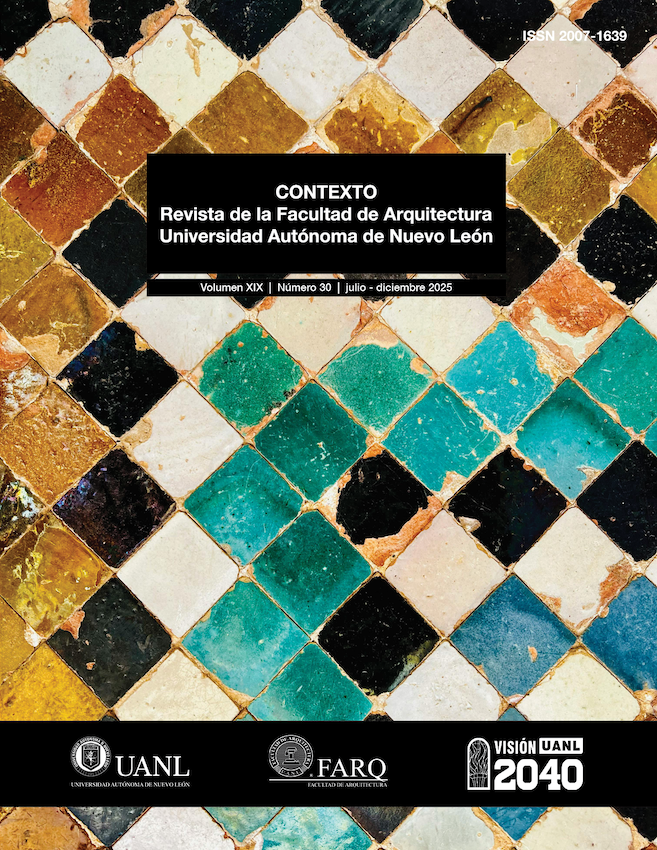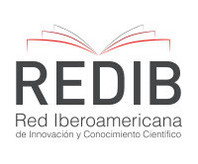Analysis of the impact of vernacular housing transfiguration on thermal comfort
Case studies: Zihuatanejo and Chilpancingo de los Bravo, Guerrero, Mexico
DOI:
https://doi.org/10.29105/contexto19.30-469Keywords:
thermal comfort, vernacular housing, housing transfigurationAbstract
Vernacular housing has undergone gradual changes in its configuration until it has been totally or partially transformed, losing characteristics that identified it as typical of the area. These changes address four dimensions of transformation—including the replacement of materials in the building envelope—generally carried out without professional advice, and have an impact on the habitability of the dwelling. To determine the extent of the impact on indoor thermal comfort, a theoretical comparison was made between a baseline case that reflects the original characteristics of traditional housing in Chilpancingo and Zihuatanejo, Guerrero, Mexico, with a semi-transfigured baseline case and a transfigured baseline case using simulations with OpenStudio and analysis of results with the analytical method and adaptive model. The result is an average annual increase in indoor air temperature for the semi-transfigured and transfigured prototypes of 0.82 °C and 1.06 °C, respectively, in Chilpancingo, and 0.91 °C and 1.37 °C in Zihuatanejo. While the adaptive model maintained comfort results in all cases, the analytical method indicates slightly warm thermal sensations in Zihuatanejo and slightly cold sensations in Chilpancingo.
Downloads
References
Aguirre, P. A. B. (2012). Transformaciones y características de la vivienda vernácula en el barrio Aranjuez de Medellín a partir de las formas de habitar de sus moradores desde principios del …. bdigital.unal.edu.co. http://www.bdigital.unal.edu.co/6841/
Alegría-Sala, A., Lopez, D. M., Casals, L. C., Fonollosa, J., & Macarulla, M. (2024). The dilemma of variables assumptions in thermal comfort calculations for educational buildings: To Simplify or Not? Journal of Building Engineering, 84. https://doi.org/10.1016/j.jobe.2023.108404 DOI: https://doi.org/10.1016/j.jobe.2023.108404
Ascencio López, O., Jerónimo Vargas, C., & Romero Pérez, F. J. (2014). Patrones de transfiguración de la vivienda vernácula. Caso de estudio: Chilapa de Álvarez(Guerrero, México. Territorios, 16(31), 163–184. https://doi.org/10.12804/territ31.2014.07 DOI: https://doi.org/10.12804/territ31.2014.07
Ascencio López, O. (2012). La evolución de la vivienda vernácula. Plaza y Valdés.
Ascencio López, O., Jerónimo Vargas, C., García Villalva, M. Á., & Romero Pérez, F. J. (2013). El proceso de transformación de la vivienda vernácula en la región centro de Guerrero (1a ed.). Universidad Autónoma de Guerrero.
Auliciems, A., & Szokolay, S. (1997). Thermal Comfort. Notes of passive and low energy architecture international. PLEA - University of Queensland, 3. https://www.yumpu.com/en/document/read/28357118/plea-note-3-thermal-comfort-passive-low-energy-architecture
Cheung, T., Schiavon, S., Parkinson, T., Li, P., & Brager, G. (2019). Analysis of the accuracy on PMV – PPD model using the ASHRAE Global Thermal Comfort Database II. Building and Environment, 153, 205–217. https://doi.org/10.1016/j.buildenv.2019.01.055 DOI: https://doi.org/10.1016/j.buildenv.2019.01.055
CONAGUA. (2024). Información Estadística Climatológica. https://smn.conagua.gob.mx/es/climatologia/informacion-climatologica/informacion-estadistica-climatologica.
Crespo, G. A. (1995). Arquitectura vernácula en la provincia de Palencia (vivienda tradicional). Publicaciones de la Institución Tello Téllez de …. http://dialnet.unirioja.es/servlet/dcfichero_articulo?codigo=2486403
d’Ambrosio Alfano, F. R., Pepe, D., Riccio, G., Vio, M., & Palella, B. I. (2023). On the effects of the mean radiant temperature evaluation in the assessment of thermal comfort by dynamic energy simulation tools. Building and Environment, 236. https://doi.org/10.1016/j.buildenv.2023.110254 DOI: https://doi.org/10.1016/j.buildenv.2023.110254
de Dear, R., & Brager, G. S. (1998). Developing an adaptive model of thermal comfort and preference. En UC Berkeley: Center for the Built Environment. https://escholarship.org/uc/item/4qq2p9c6.
Escandón, R., Suárez, R., Alonso, A., & Mauro, G. M. (2022). Is indoor overheating an upcoming risk in southern Spain social housing stocks? Predictive assessment under a climate change scenario. Building and Environment, 207. https://doi.org/10.1016/j.buildenv.2021.108482 DOI: https://doi.org/10.1016/j.buildenv.2021.108482
Galindo, C., & Delgado, J. (2006). Los espacios emergentes de la dinámica rural - urbana. Problemas De Desarrollo. Revista Latinoamericana De Economia, 187–216. http://redalyc.uaemex.mx/pdf/118/11820100008.pdf
Gómez Azpeitia, G., Bojórquez Morales, G., & Ruiz Torres Raúl Pável. (2007). Confort termico dos enfoques enfrentados. Palapa, 2(1), 45–57.
González Cruz, E. M. (s/f). Selección de materiales en la concepción arquitectónica bioclimática. Recuperado el 20 de agosto de 2023, de https://www.academia.edu/18215888/SELECCION_DE_MATERIALES_EN_LA_CONCEPCION_ARQUITECTONICA_BIOCLIM%C3%81TICA
Hou, Y., Cao, B., Zhu, Y., Zhang, H., Yang, L., Duanmu, L., Lian, Z., Zhang, Y., Zhai, Y., Wang, Z., Zhou, X., & Xie, J. (2023). Temporal and spatial heterogeneity of indoor and outdoor temperatures and their relationship with thermal sensation from a global perspective. Environment International, 179, 108174. https://doi.org/10.1016/j.envint.2023.108174 DOI: https://doi.org/10.1016/j.envint.2023.108174
ICOMOS. (1999, octubre). Carta del patrimonio vernáculo construido. https://www.icomos.org/images/DOCUMENTS/Charters/vernacular_sp.pdf.
Industria de la construcción - Aislamiento térmico - Valor R para las envolventes de vivienda por zona térmica para la República Mexicana - Especificaciones y verificación, Pub. L. No. NMX-C-460-ONNCCE-2009, ONNCCE (2009).
Industria de la construcción - Ergonomía del ambiente térmico - Determinación analítica e interpretación del confort térmico mediante el cálculo de los índices VME y PEI y los criterios de confort térmico local, Pub. L. No. NMX-C-7730-ONNCCE-2018, ONNCCE (2019).
Jirón, P., & Mansilla, P. (2014). Las consecuencias del urbanismo fragmentador en la vida cotidiana de habitantes de la ciudad de Santiago. EURE, 40(121), 5–28. http://www.redalyc.org/resumen.oa?id=19631675001 DOI: https://doi.org/10.4067/S0250-71612014000300001
Juárez Sánchez, J. P. (2022). De la vivienda tradicional, a la vivienda popular rural en el centro occidente del estado de Puebla, México. Revista INVI, 37(106). https://doi.org/10.5354/0718-8358.2022.66515 DOI: https://doi.org/10.5354/0718-8358.2022.66515
Kramer, T., Garcia-Hansen, V., Omrani, S., Zhou, J., & Chen, D. (2023). Personal differences in thermal comfort perception: Observations from a field study in Brisbane, Australia. Building and Environment, 245. https://doi.org/10.1016/j.buildenv.2023.110873 DOI: https://doi.org/10.1016/j.buildenv.2023.110873
López, E. A. C. (1986). El proceso de formación de un espacio rur-urbano Lardero (La Rioja). Cuadernos de investigación geográfica. http://dialnet.unirioja.es/servlet/dcfichero_articulo?codigo=81461
Mancini, F., Nardecchia, F., Groppi, D., Ruperto, F., & Romeo, C. (2020). Indoor environmental quality analysis for optimizing energy consumptions varying air ventilation rates. Sustainability (Switzerland), 12(2). https://doi.org/10.3390/su12020482 DOI: https://doi.org/10.3390/su12020482
Manu, S., Shukla, Y., Rawal, R., Thomas, L. E., & de Dear, R. (2016). Field studies of thermal comfort across multiple climate zones for the subcontinent: India Model for Adaptive Comfort (IMAC). Building and Environment, 98, 55–70. https://doi.org/10.1016/j.buildenv.2015.12.019 DOI: https://doi.org/10.1016/j.buildenv.2015.12.019
Marsh, A. (2017, junio 1). Weather Data. https://andrewmarsh.com/software/weather-data-web/.
Martínez-Aguilar, J. M., & Bedolla-Arroyo, E. (2021). Transformación de la vivienda tradicional de Michoacán. Problemáticas y acciones de conservación. Revista Legado de Arquitectura y Diseño, 16(30), 4–13. DOI: https://doi.org/10.36677/legado.v16i30.15849
Molinatti, F. (2013). Segregación residencial socioeconómica en la ciudad de Córdoba (Argentina): Tendencias y patrones espaciales. Revista Invi, 28(79), 61–94. http://www.scielo.cl/scielo.php?script=sci_arttext&pid=S0718-83582013000300003&lng=en&nrm=iso&tlng=en DOI: https://doi.org/10.4067/S0718-83582013000300003
OneBuilding.org. (2023, agosto 25). climate.onebuilding. https://climate.onebuilding.org/default.html.
Pan, J., Li, N., Zhang, W., He, Y., & Hu, X. (2022). Investigation based on physiological parameters of human thermal sensation and comfort zone on indoor solar radiation conditions in summer. Building and Environment, 226, 109780. https://doi.org/10.1016/j.buildenv.2022.109780 DOI: https://doi.org/10.1016/j.buildenv.2022.109780
Rudofsky, B. (2000). Constructores prodigiosos. Arbol Editorial.
Ruiz-Tagle, J., & López M, E. (2014). El estudio de la segregación residencial en Santiago de Chile: revisión crítica de algunos problemas metodológicos y conceptuales. EURE (Santiago), 40(119), 25–48. http://www.scielo.cl/scielo.php?script=sci_arttext&pid=S0250-71612014000100002&lng=en&nrm=iso&tlng=en DOI: https://doi.org/10.4067/S0250-71612014000100002
Sánchez, M. A., & Melendo, J. M. A. (2020). La vivienda vernácula en Burkina Faso: transformaciones de los modos de habitar de las culturas del Sahel. Estudios de Asia y África, 56(1), 37–73. https://doi.org/10.24201/eaa.v56i1.2591 DOI: https://doi.org/10.24201/eaa.v56i1.2591
Thermal Environmental Condictions for Human Occupancy, Pub. L. No. ANSI/ASHRAE Standard 55-2020, ASHRAE (2021).
Tillería González, J. (2010). La arquitectura sin arquitectos, algunas reflexiones sobre arquitectura vernácula. Revista AUS, 8, 12–15. DOI: https://doi.org/10.4206/aus.2010.n8-04
Zetina-Rodriguez, M. del C. (2017). La transformación de un sector de las viviendas vernáculas en Ciudad Juárez, Chihuahua 1920-1940. Revista Legado de Arquitectura y Diseño, 1(22).
Downloads
Published
How to Cite
Issue
Section
License
Copyright (c) 2025 Osvaldo Ascencio López, José Francisco Sotelo Leyva, Francisco Javier Romero Pérez

This work is licensed under a Creative Commons Attribution-NonCommercial 4.0 International License.
The authors who publish in this journal accept the following conditions:
1. The authors keep the copyright and give the journal the right of the first publication, with their content registered under the Creative Commons License, which lets third parties to use the published material as long as they mention the authors and the first publication from the journal.
2. The authors can make other independent and additional contractual agreements for the non-exclusive distribution of the version of the article published in the journal (for example an institutional repository or a book) provided that they explicitly mention that the content was first published in CONTEXTO. Revista de la Facultad de Arquitectura de la Universidad Autónoma de Nuevo León..














.png)





